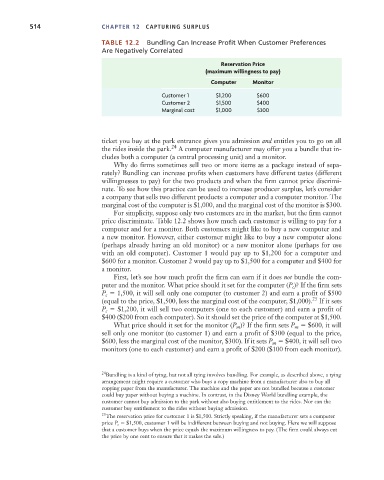Page 540 - Microeconomics, Fourth Edition
P. 540
c12capturingsurplus.qxd 7/22/10 10:41 AM Page 514
514 CHAPTER 12 CAPTURING SURPLUS
TABLE 12.2 Bundling Can Increase Profit When Customer Preferences
Are Negatively Correlated
Reservation Price
(maximum willingness to pay)
Computer Monitor
Customer 1 $1,200 $600
Customer 2 $1,500 $400
Marginal cost $1,000 $300
ticket you buy at the park entrance gives you admission and entitles you to go on all
the rides inside the park. 24 A computer manufacturer may offer you a bundle that in-
cludes both a computer (a central processing unit) and a monitor.
Why do firms sometimes sell two or more items as a package instead of sepa-
rately? Bundling can increase profits when customers have different tastes (different
willingnesses to pay) for the two products and when the firm cannot price discrimi-
nate. To see how this practice can be used to increase producer surplus, let’s consider
a company that sells two different products: a computer and a computer monitor. The
marginal cost of the computer is $1,000, and the marginal cost of the monitor is $300.
For simplicity, suppose only two customers are in the market, but the firm cannot
price discriminate. Table 12.2 shows how much each customer is willing to pay for a
computer and for a monitor. Both customers might like to buy a new computer and
a new monitor. However, either customer might like to buy a new computer alone
(perhaps already having an old monitor) or a new monitor alone (perhaps for use
with an old computer). Customer 1 would pay up to $1,200 for a computer and
$600 for a monitor. Customer 2 would pay up to $1,500 for a computer and $400 for
a monitor.
First, let’s see how much profit the firm can earn if it does not bundle the com-
puter and the monitor. What price should it set for the computer (P )? If the firm sets
c
P 1,500, it will sell only one computer (to customer 2) and earn a profit of $500
c
(equal to the price, $1,500, less the marginal cost of the computer, $1,000). 25 If it sets
P $1,200, it will sell two computers (one to each customer) and earn a profit of
c
$400 ($200 from each computer). So it should set the price of the computer at $1,500.
What price should it set for the monitor (P )? If the firm sets P $600, it will
m
m
sell only one monitor (to customer 1) and earn a profit of $300 (equal to the price,
$600, less the marginal cost of the monitor, $300). If it sets P $400, it will sell two
m
monitors (one to each customer) and earn a profit of $200 ($100 from each monitor).
24 Bundling is a kind of tying, but not all tying involves bundling. For example, as described above, a tying
arrangement might require a customer who buys a copy machine from a manufacturer also to buy all
copying paper from the manufacturer. The machine and the paper are not bundled because a customer
could buy paper without buying a machine. In contrast, in the Disney World bundling example, the
customer cannot buy admission to the park without also buying entitlement to the rides. Nor can the
customer buy entitlement to the rides without buying admission.
25 The reservation price for customer 1 is $1,500. Strictly speaking, if the manufacturer sets a computer
price P c $1,500, customer 1 will be indifferent between buying and not buying. Here we will suppose
that a customer buys when the price equals the maximum willingness to pay. (The firm could always cut
the price by one cent to ensure that it makes the sale.)

